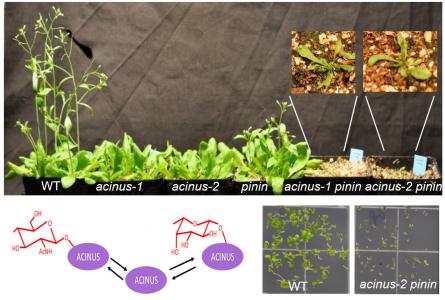Sleuthing Molecular Pathways for Plant Growth and Metabolism
Carnegie In The News
"Take Moises Exposito-Alonso for example; during his childhood in southern Spain, he watched climate change alter Mediterranean forests into dry desert. Now, he leads a research lab at Stanford in California where he uses genomics to predict plant species’ vulnerabilities to climate change."

Plant photosynthesis converts carbon dioxide into sugar for energy. The amount of sugar available to an organism or cell is monitored to control normal metabolism and growth in both plants and animals.
One control mechanism is to modify proteins with sugar molecules, including O-linked acetylglucosamine (O-GlcNAc). Protein O-GlcNAc modification is critical to a range of cellular, physiological, and disease processes in mammals. Carnegie’s Shouling Xu and her team have conducted groundbreaking research on its role in plants and were recently awarded a National Institutes of Health (NIH) grant to further study this critical system.
In humans, altered levels of O-GlcNAc modification are associated with various diseases, including diabetes, cardiovascular disease, neuron degeneration diseases, and cancer. With colleagues, Xu recently identified, for the first time, 262 proteins and their sites that are modified by O-GlcNAc in the model plant Arabidopsis thaliana. Many of these proteins are known to regulate important processes, such as gene activation, hormone response, and the timing of flowering. Their results laid the foundation to understand the importance of O-GlcNAc modification to plant growth, and potentially to crop productivity.
More recently, Xu’s team—including Carnegie’s Yang Bi, Zhiping Deng, Weimin Ni, Ruben Shrestha, Dasha Savage, Thomas Hartwig, Sunita Patil, Su Hyun Hong, and Zhiyong Wang—conducted comprehensive analyses on one O-GlcNAcylated protein, AtACINUS, an evolutionarily old component involved in turning genes on (transcription) and alternatively splicing RNAs to generate two or more different products from the same gene. Interestingly, AtACINUS is found to be attached by both O-GlcNAc and O-Fucose, another sugar molecule. Suppressing AtACINUS and its distant relative AtPININ causes severe growth defects, delayed seed germination, and late flowering. Their results demonstrate that modifying proteins with sugar molecules—O-glycosylation—is important to regulating alternative RNA splicing.

AtACINUS and AtPININ are two evolutionarily old proteins that regulate flowering time and seed germination.
AtACINUS and AtPININ are two evolutionarily old proteins that regulate flowering time and seed germination. The photo (top) shows the difference between the growth patterns of wild-type Arabidopsis (top, far left, WT) and the mutants lacking AtACINUS and its distant relative PININ. AtACINUS is subjected to regulation by nutrient sensing through O-GlcNAcylation and O-fucosylation. The study uncovers a molecular mechanism by which the nutrient modulates plant growth and development.
Images courtesy Shouling Xu and Danbi Byun, Carnegie Institution for Science
The NIH five-year grant will further this work to understand the molecular machineries involved in regulating gene expression and alternative splicing, as well as how sugar affects these processes. Understanding these molecular mechanisms is a critical step to improve human health and crop yield. Xu’s group will take advantage of state-of-the-art mass spectrometry to embark on a detailed molecular dissection of the alternative splicing factor AtACINUS and the roles of O-Glycosylation in plants.





The Xu lab members are from left to right: Ruben Shrestha, Danbi Byun, Malika Kaderali, Andres Reyes, and Shouling Xu.
Images courtesy Carnegie Institution for Science
